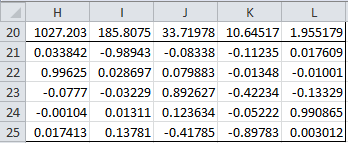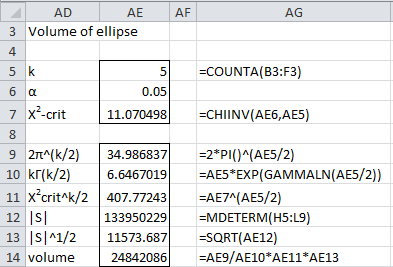As we observe in Multivariate Normal Distribution Basic Concepts, the 1–α hyper-ellipse plays a similar role to the confidence interval in univariate statistics. We now describe some additional characteristics of these hyper-ellipses, and in particular, their relationship with eigenvalues.
Basic Properties
The axes of the ellipse have lengths that are a function of the eigenvalues of the Σ. Also, each axis is in the direction of the eigenvector corresponding to one of the eigenvalues.
Figure 1 – Confidence ellipse
The half-length of the axis corresponding to eigenvalue λ is given by the formula
where is the critical value for χ2(k).
All these properties extend to the case where k > 2. In this case, we speak of hyper-ellipses (or ellipsoids) instead of ellipses.
The volume of the hyper-ellipse (or area in the case where k = 2) is given by the function
Note too that by Property 1 of Eigenvalues and Eigenvectors, |Σ| = product of the eigenvalues of Σ.
Example
Example 1: Calculate the eigenvalues and eigenvectors of the sample covariance matrix for Example 1 of Descriptive Multivariate Statistics.
Figure 2 – Eigenvalues and eigenvectors for Example 1
Using the Real Statistics array function eVECTORS(H5:L9) we can generate the output displayed in Figure 2. Alternatively, we can get the same result by using the Real Statistics Matrix data analysis tool (as described in Matrix Operations and Real Statistics Data Analysis Tools) and choosing the Eigenvalue/eigenvector option. The top row of Figure 2 lists the 5 eigenvalues. Below each eigenvalue is a corresponding unit eigenvector.
As noted above, the half-lengths of the axes corresponding to the eigenvalues are
where is the critical value for χ2(5).
Using the sample covariance matrix as an approximation for the population covariance matrix and the eigenvalues obtained in Figure 2, the lengths of these axes are:
Figure 3 – Axes lengths for Example 1
The volume of the 95% confidence ellipse is 24,842,086 calculated as follows:
Figure 4 – Volume of 95% confidence ellipse for Example 1
Note that |S| (cell A12) can also be calculated as the product of the five eigenvalues.
Worksheet Functions
Real Statistics Functions: The Real Statistics Resource Pack provides the following functions
CONF_MNORM(R1, alpha, iter): array function that returns a column array with the lengths of the axes in the 1-alpha confidence ellipse based on the data in R1
CONF_VOLUME(R1, alpha, iter): returns the volume (area if R1 only has two columns) of the 1-alpha confidence ellipse based on the data in R1.
The default of alpha is .05. iter = # of iterations in calculating eigenvalues (default 100).
For Example 1, the output from =CONF_MNORM(B4:F30) is the transpose of range X4:AB4 of Figure 4. The output from =CONF_VOLUME(B4:F30) is the value in cell U18.
Examples Workbook
Click here to download the Excel workbook with the examples described on this webpage.
References
Johnson, R. A., Wichern, D. W. (2007) Applied multivariate statistical analysis. 6th Ed. Pearson
https://mathematics.foi.hr/Applied%20Multivariate%20Statistical%20Analysis%20by%20Johnson%20and%20Wichern.pdf
Penn State (2013) Geometry of the multivariate normal distribution
https://online.stat.psu.edu/stat505/lesson/4/4.6




Hi Charles,
I am using your tool to calculate a 95% Confidence Ellipse Analysis Tool But I need a calculation formula for this.
Do you have a reference for computing the Confidence Ellipse area function?
Thank you.
Hello Atsu,
How to calculate the confidence ellipse is described at;
https://real-statistics.com/multivariate-statistics/multivariate-normal-distribution/confidence-ellipse/
I can’t recall the reference for the area of the confidence ellipse, but perhaps the following would be helpful:
Johnson, R. A., Wichern, D. W. (2007) Applied multivariate statistical analysis. 6th ed. Pearson Prentice-Hall
https://www.webpages.uidaho.edu/~stevel/519/Applied%20Multivariate%20Statistical%20Analysis%20by%20Johnson%20and%20Wichern.pdf
https://stats.stackexchange.com/questions/67422/volume-of-the-95-confidence-ellipsoid
Charles
Hi Charles,
Have you a reference for the function that compute the volume of the hyper-ellipse?
Thank you.
Hi Manu,
See the following webpage:
https://onlinecourses.science.psu.edu/stat505/node/36
Charles
Hi Charles,
the web is not found.
Atsu
Hi Atsu,
Sorry, but I don’t understand your comment. What can’t you find on the web?
Charles
Thank you Charles for these information. In this case what will be the equation of the hyper-ellipses if I wanted to code it in VBA or Fortran?
Is this sentence “The axes of the ellipse have lengths which are a function of the eigenvalues” also true for the ellipsoid? Thank you
Yes.